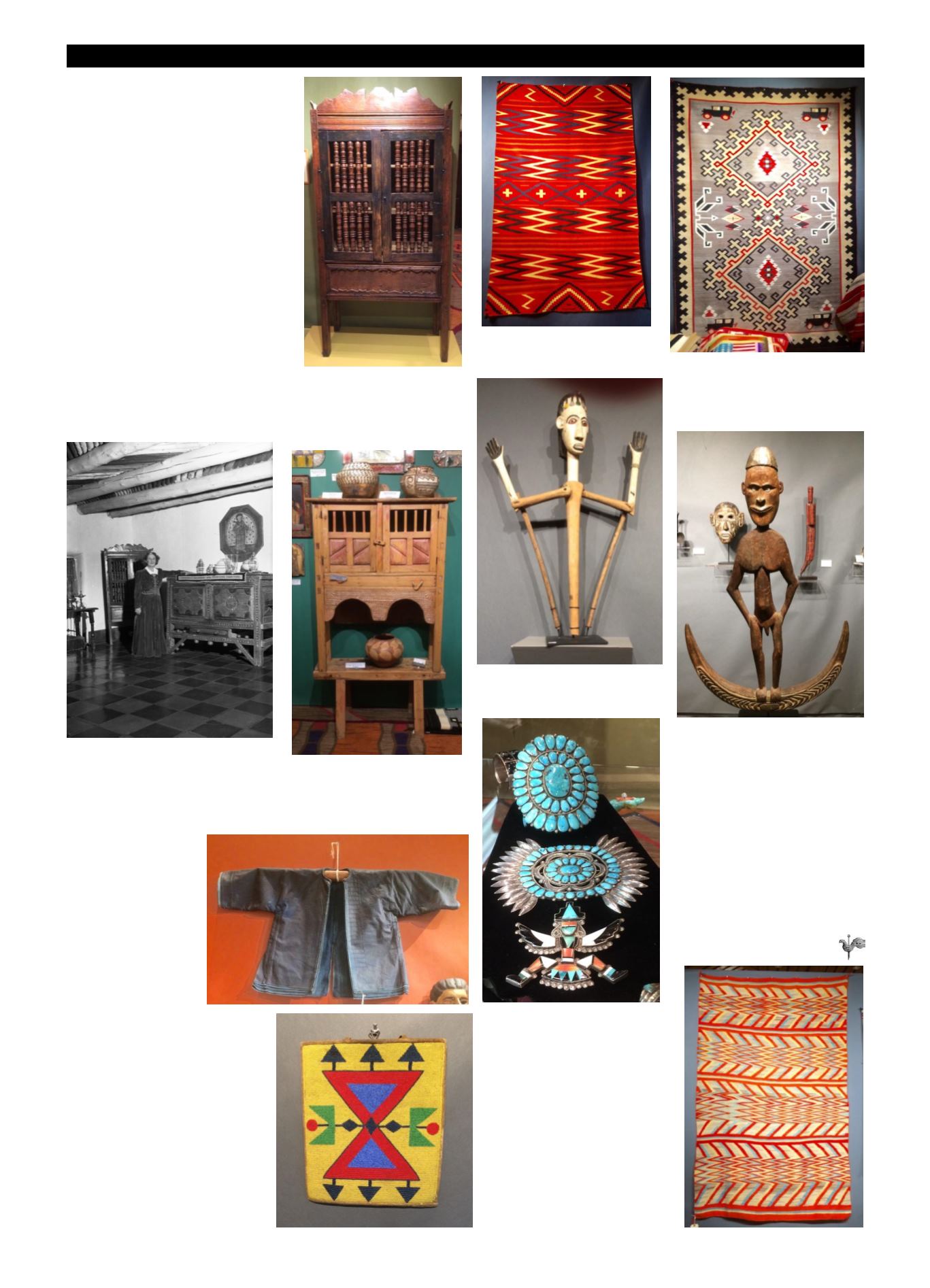

Maine Antique Digest, December 2016 13-C
-
SHOW -
13-C
This early 1800s New Mexican spindle trastero once
belonged to Mabel Dodge Luhan and was collected
shortly after her move from New York to Taos in
1918. In the 1940s Mabel and her fourth husband,
Tony Luhan of Taos Pueblo, gave the trastero to their
friend writer Frank Waters, known for his novels
and historical works about the American Southwest.
The trastero retains much of its original surface, its
decorative front and side crests, hinges, and shelves,
and was priced at $125,000 by Coulter-Brooks Art
and Antiques, Santa Fe. Lane Coulter pointed out
that “At the time this cabinet was made, NewMexico
was the most northern remote outpost of colonial
Spain. Tools and especially wrought iron were hauled
up the Chihuahua Trail twice a year from central
Mexico and were expensive and scarce. There were
no sawmills, and lathes for making spindles were
only foot-treadle powered.” Jan Brooks, awed by
the age and rarity of the piece, said, “Apparently
no furniture survived the Pueblo Indian Revolt of
1680 when the Mission churches and the homes of
fleeing Spanish settlers were burned.” Brooks said,
“It’s really amazing when you look at the early dates
when towns like Taos were established. The census
records show us that carpenters were among the
first new settlers to come to New Mexico after the
Spanish Reconquest in 1696. They helped furnish the rebuilt churches and crafted furniture
for homes of the settlers. When we compare what was happening back east concurrently, we
see right away what an achievement it was to make such fine furniture by hand in this remote
area, so far from central Mexico. By the first quarter of the 19th century in New England,
you already had water-powered equipment like lathes to turn spindles. This trastero, made
completely with hand tools, dates to the early years of the nineteenth century.”
This 1940s-50s image shows Mabel Dodge
Luhan in her Taos living room in front of the
trastero offered by Coulter-Brooks. Photo
by Santa Fe photographer John Candelario
and courtesy Palace of the Governors Photo
Archives (NMHM/DCA), negative number
179248.
This circa 1870 Navajo child’s blanket
was offered by dealer Jerry Becker of
Pine, Colorado.
Susan De Jong of Southwest Accents,
Santa Fe, was showing a special exhibit of
early Crystal rugs in her booth. This 1920s
Crystal decorated with a Model T measures
5' x 8' (“very large”) and cost $35,000.
Ignacio Villareal of Santa Fe priced this
1940s-50s marionette from the Bamana
tribe of Bali at $3000.
San Francisco dealer Joe Loux was asking
$1800 for this early 19th-century hook from
Middle Sepik River, Papua New Guinea.
“Small but good sales in the medium price
range have driven the show,” Loux told
M.A.D.
He liked the “strong gate” and
called Whitehawk a “very energetic and
well-attended show.”
Robert Gallegos of Albuquerque, New
Mexico, was asking $2650 for this 1890s
Mexican trastero. On the top were (left)
a circa 1870 Zuni olla, $5500; (right)
an 1870 Zuni pottery jar, $2250; and
below was a 1900-20 Zia jar, $3500.
New Salem, Massachusetts,
dealer Robert Bauver offered
a selection of historic Zuni
material from the 1930s-50s,
priced from $1200 to $4500.
The Leekya bear, partially
seen back right, was priced at
$4800. Bauver said, “The usual
discriminating buyers made
for a successful show.”
Ross Traut of New York City was asking
$25,000 for this circa 1890 Navajo wedge-
weave blanket (50" x 79"). Traut called
the show great, said he’d sold blankets
and silver, and said he “appreciated the
interest in the material.”
Liz Lees of Marina del Rey,
California, was asking $450
for this multilayered child’s
indigo jacket from a Chinese
hill tribe, 1920s-40s. This was
her 12th year at Whitehawk,
where business is “consistently
good.” Longtime producer of
the San Francisco Tribal and
Textile Arts Show, Lees recently
sold the show to Santa Fe/Cal-
ifornia show producers Kim
Martindale and John Morris.
Heidi Becker of Eugene, Oregon,
priced this 1920s Plateau woman’s flat
bag with “very strong geometrics and
an unusual yellow background” at
$1500. “It’s a beautiful show,” Becker
said, “and a good show. I’m very
happy, very pleased. There have been
great crowds, with several be-backs.”











